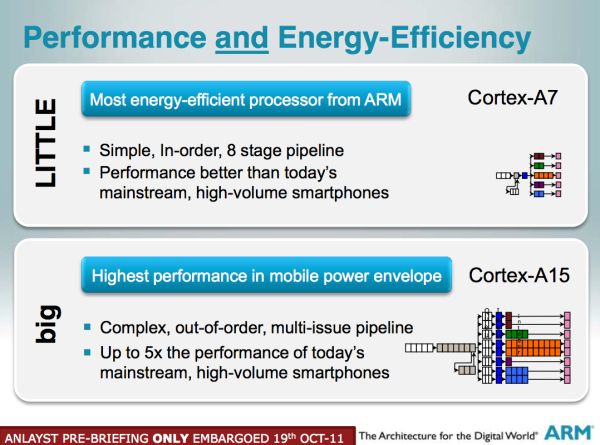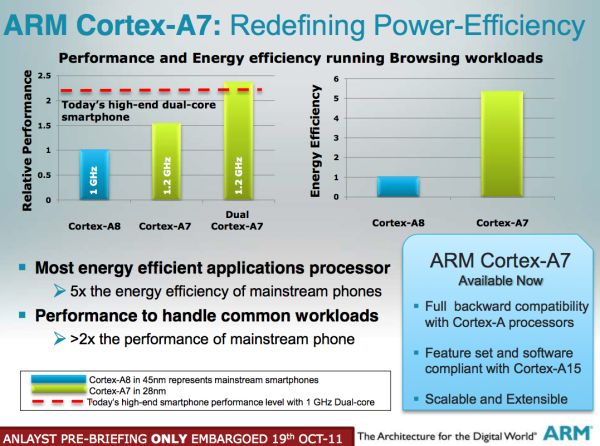ARM's Cortex A7: Bringing Cheaper Dual-Core & More Power Efficient High-End Devices
by Anand Lal Shimpi on October 19, 2011 12:31 PM EST- Posted in
- SoCs
- CPUs
- Arm
- Cortex A15
- Smartphones
- Mobile
- Cortex A7
- Tablets
How do you keep increasing performance in a power constrained environment like a smartphone without decreasing battery life? You can design more efficient microarchitectures, but at some point you’ll run out of steam there. You can transition to newer, more power efficient process technologies but even then progress is very difficult to come by. In the past you could rely on either one of these options to deliver lower power consumption, but these days you have to rely on both - and even then it’s potentially not enough. Heterogeneous multiprocessing is another option available - put a bunch of high performance cores alongside some low performance but low power cores and switch between them as necessary.
NVIDIA recently revealed it was doing something similar to this with its upcoming Tegra 3 (Kal-El) SoC. NVIDIA outfitted its next-generation SoC with five CPU cores, although only a maximum of four are visible to the OS. If you’re running light tasks (background checking for email, SMS/MMS, twitter updates while your phone is locked) then a single low power Cortex A9 core services those needs while the higher performance A9s remain power gated. Request more of the OS (e.g. unlock your phone and load a webpage) and the low power A9 goes to sleep and the 4 high performance cores wake up.
While NVIDIA’s solution uses identical cores simply built using different transistors (LP vs. G), the premise doesn’t change if you move to physically different cores. For NVIDIA, ARM didn’t really have a suitable low power core thus it settled on a lower power Cortex A9. Today, ARM is expanding the Cortex family to include a low power core that can either be used by itself or as an ISA-compatible companion core in Cortex A15 based SoCs. It’s called the ARM Cortex A7.
Architecture
Starting with the Cortex A9, ARM moved to an out-of-order execution core (instructions can be reordered around dependencies for improved parallelism) - a transition that we saw in the x86 space back in the days of the Pentium Pro. The Cortex A15 continues the trend as an OoO core but increases the width of the machine. The Cortex A7 however takes a step back and is another simple in-order core capable of issuing up to two instructions in parallel. This should sound a lot like the Cortex A8, however the A7 is different in a number of areas.
The A8 is a very old design with work originally beginning on the core in 2003. Although ARM offered easily synthesizable versions of the core, in order to hit higher clock speeds you needed to include a lot of custom logic. The custom design requirements on A8 not only lengthened time to market but also increased development costs, limiting the A8’s overall reach. The Cortex A7 on the other hand would have to be fully synthesizable while being able to deliver good performance. ARM could leverage process technology advancements over the past few years to deliver clock speed and competitive power consumption, but it needed a revised architecture to meet the cost and time to market requirements.
The Cortex A7 features an 8-stage integer pipeline and is capable of dual-issue. Unlike the Cortex A8 however, the A7 cannot dual-issue floating point or NEON instructions. There are other instructions that turn the A7 into a single-issue machine as well. The integer execution cluster is quite similar to the Cortex A8, although the FPU is fully pipelined and more compact than its older brother.
Limiting issue width for more complex instructions helps keep die size in check, which was a definite goal for the core. ARM claims a single Cortex A7 core will measure only 0.5mm2 on a 28nm process. On an equivalent process node ARM expects customers will be able to implement an A7 in 1/3 - 1/2 the die area of a Cortex A8. As a reference, an A9 core uses about the same (if not a little less) die area as an A8 while an A15 is a bit bigger than both.
| Architecture Comparison | |||||||||
| ARM11 | ARM Cortex A7 | ARM Cortex A8 | ARM Cortex A9 | Qualcomm Scorpion | Qualcomm Krait | ||||
| Decode | single-issue | partial dual-issue | 2-wide | 2-wide | 2-wide | 3-wide | |||
| Pipeline Depth | 8 stages | 8 stages | 13 stages | 8 stages | 10 stages | 11 stages | |||
| Out of Order Execution | N | N | N | Y | Partial | Y | |||
| Pipelined FPU | Y | Y | N | Y | Y | Y | |||
| NEON | N/A | Y (64-bit wide) | Y (64-bit wide) | Optional MPE (64-bit wide) | Y (128-bit wide) | Y (128-bit wide) | |||
| Process Technology | 90nm | 40nm/28m | 65nm/45nm | 40nm | 40nm | 28nm | |||
| Typical Clock Speeds | 412MHz | 1.5GHz (28nm) | 600MHz/1GHz | 1.2GHz | 1GHz | 1.5GHz | |||
Despite the limited dual issue capabilities, ARM is hoping for better performance per clock and better overall performance out of the Cortex A7 compared to the Cortex A8. Branch prediction performance is improved partly by using a more modern predictor, and partly because the shallower pipeline lessens the mispredict penalty. The Cortex A7 features better prefetching algorithms to help improve efficiency. ARM also includes a very low latency L2 cache (10 cycles) with its Cortex A7 design, although actual latency can be configured by the partner during implementation.
Note that in decoding bound scenarios, the Cortex A7 will offer the same if not lower performance than a Cortex A8 due to its limited dual-issue capabilities. The mildly useful DMIPS/MHz ratings of ARM’s various cores are below:
| Estimated Core Performance | |||||||||
| ARM11 | ARM Cortex A7 | ARM Cortex A8 | ARM Cortex A9 | Qualcomm Scorpion | Qualcomm Krait | ||||
| DMIPS/MHz | 1.25 | 1.9 | 2.0 | 2.5 | 2.1 | 3.3 | |||
The big news is the Cortex A7 is 100% ISA compatible with the Cortex A15, this includes the new virtualization instructions, integer divide support and 40-bit memory addressing. Any code running on an A15 can run on a Cortex A7, just slower. This is a very important feature as it enables SoC vendors to build chips with both Cortex A7 and Cortex A15 cores, switching between them depending on workload requirements. ARM calls this a big.LITTLE configuration.












75 Comments
View All Comments
introiboad - Thursday, October 20, 2011 - link
I believe it's too early in the development stage and no public data is available for the T-604 nor Rogue (VR6 series). This should change in the coming months I assume, since they announced both quite a while backfrench toast - Thursday, October 20, 2011 - link
cheers, hopefully they will spill the beans soon!ltcommanderdata - Wednesday, October 19, 2011 - link
So they are envisioning a SoC with dual A15 and dual A7 cores, the A15 pair used for high performance and the A7 pair used for low power. Is there a way to use both the A15 and A7 together if there is thermal room since they are the same ISA?fic2 - Wednesday, October 19, 2011 - link
From the aritcle:ARM did add that SoC vendors are free to expose all cores to the OS if they would like, although would obviously require OS awareness of the different core types.
geniekid - Wednesday, October 19, 2011 - link
You could also focus on advancing battery technology.I understand battery tech is much more mature than SoC tech, so revolutionary advancements in this field may be wishful thinking, but it would be cool to see what things are being done in the R&D labs of our smartphone battery producers :)
bjacobson - Wednesday, October 19, 2011 - link
meh that's a dead end.Lithium batteries only store 30% or so of what they are capable of storing. Why don't they? Because at full energy density that energy is just asking to get out-- a pin prick into the cell would set it on fahr.
Etsp - Thursday, October 20, 2011 - link
There are technologies that are much safer than Li-ion currently in development. While Pros/Cons differ between different battery technologies, developing a better battery is never a dead end.That said, I'm certain that there are advancements in battery technology all the time, we just read articles about them.
Etsp - Thursday, October 20, 2011 - link
We just *don't* read articles about them.Steel77 - Thursday, October 20, 2011 - link
Battery technology is by no means "more mature". The techniques developed that are in use today are actually pretty recent advances when you consider that high-output LiFePO4 batteries are a pretty recent invention, and aren't even really on the market yet.Current batteries are dangerous because they use LiCoO4, which decomposes at high temperature to release lithium metal and oxygen. I think it's obvious why that's a bad setup, but we already have a number of potential solutions fairly far along through the research stage.
Other potential advances have come from some recent potentially game-changing success in 3D batteries, which use materials such as aerogels, foams, etc. to give exceptionally high surface areas, which gives them the potential to have much higher power and energy densities. This system is just more difficult because it requires even coatings of subsequent layers, which requires somewhat complicated, though potentially very efficient, chemical methods.
So battery research is extremely important, and there's a lot of progress being made, though it's suffering right now due to research budget shortfalls, at least in the USA.
secretmanofagent - Wednesday, October 19, 2011 - link
This is not my area of expertise, but it really seems like Krait would have an advantage over this design. Am I reading into this incorrectly?